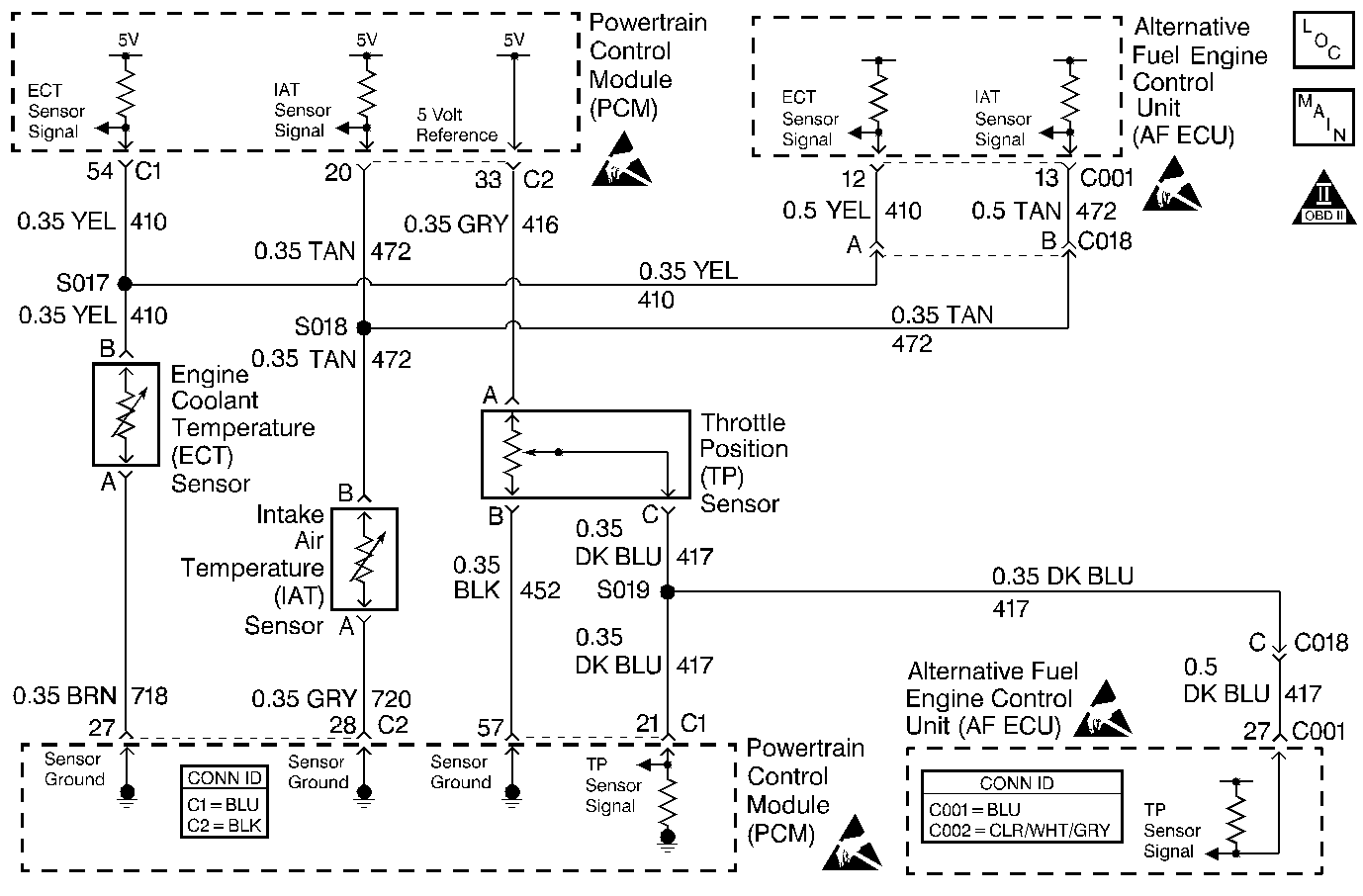
Circuit Description
The Engine Coolant Temperature (ECT) sensor is a thermistor. The ECT thermistor has high resistance when cold and low resistance when hot. The gasoline Control Module (VCM / PCM or ECM) supplies about 5 volts on the ECT signal circuit. The gasoline Control Module also supplies a ground circuit to the ECT sensor. When ECT resistance is high (cold sensor) the ECT signal voltage remains near the supplied 5 volts. As the ECT sensor warms and resistance drops, more signal circuit voltage is pulled lower to the sensor ground. The gasoline Control Module and the AF ECU monitor the ECT signal circuit voltage in order to determine the engines temperature.
This DTC is used to indicate an ECT signal circuit voltage that is below the normal operating range of the sensor.
Conditions for Running the DTC
| • | The engine is operating on alternative fuel. |
| • | The engine has been operating for greater than 5 seconds. |
Conditions for Setting the DTC
The AF ECU monitors an ECT sensor signal voltage of less than 0.019 volts for at least 5 seconds continuously.
Action Taken When the DTC Sets
| • | A first failure of this DTC will NOT illuminate the MIL and will store as Last Test Failed but not as History. |
| • | The AF ECU will illuminate the MIL and store the DTC as History after TWO consecutive drive trips that the diagnostic runs and fails. |
| • | The AF ECU will record operating conditions at the time the DTC sets. This information will be stored as Freeze Frame data. |
Conditions for Clearing the MIL/DTC
| • | The Last Test Failed status will clear when the DTC runs and passes. |
| • | The AF ECU will turn OFF the MIL after 3 consecutive drive trips that the DTC runs and passes. |
| • | The History status will clear after 40 consecutive WARM-UP cycles with NO failures of ANY DTC. |
| • | All DTC Information can be cleared using a scan tool. |
| • | Interruption of Control Module (AF ECU / VCM / PCM or ECM) power or ground MAY clear DTC Information. Clearing DTC Information with this method is inconsistent and should not be performed. |
Diagnostic Aids
Fault Not Present
Fault Not Present indicates the condition that caused the DTC to set is intermittent and not currently present. Refer to Intermittent Conditions Symptom diagnosis for additional information. If any additional DTCs were stored proceed to the applicable DTC table in the order stated in the OBD System Check.
Test Description
The number(s) below refer to the step number(s) on the diagnostic table.
-
This step determines if the failure condition is present.
-
This step determines if the ECT sensor is shorted.
-
This step determines if a short is present in the wiring harness.
-
This step determines if the gasoline control module or the AF ECU is the cause of the shorted condition.
-
This step determines if an open circuit condition is present between the gasoline control module and the signal circuit splice.
If an open condition exists in this circuit the gasoline control module should indicate HIGH signal voltage (a high signal DTC should be set) while the AF ECU would indicate LOW signal voltage (this DTC).
Step | Action | Value(s) | Yes | No | ||||||
|---|---|---|---|---|---|---|---|---|---|---|
1 | Did you perform the AF Powertrain On-Board Diagnostic (OBD) System Check? | -- | Go to Alternative Fuels (AF) Powertrain On Board (OBD) System Check | |||||||
Does the ECT sensor data parameter indicate ECT voltage less than the specified value? | 0.019 volts | |||||||||
3 |
Does the ECT sensor data parameter indicate ECT temperature warmer than the specified value? | 148°C (298°F) | ||||||||
4 | The fault is not present. Refer to Diagnostic Aids. Are any DTC's stored that have not been diagnosed? | -- | Go to the Diagnostic Trouble Code (DTC) List | Go to Intermittent Conditions | ||||||
Disconnect the ECT sensor. Does the ECT sensor data parameter indicate ECT temperature warmer than the specified value? | 148°C (298°F) | |||||||||
Was a ECT signal circuit repair made? | -- | |||||||||
Leave the AF ECU connector disconnected. Does the ECT sensor data parameter indicate ECT temperature warmer than the specified value? | 148°C (298°F) | |||||||||
Was a wiring or terminal repair made? | -- | |||||||||
9 | Replace the ECT sensor. Refer to Engine Coolant Temperature Sensor Replacement in the Engine Controls section of the gasoline service manual. Is the replacement complete? | -- | -- | |||||||
10 |
Important: The following control module replacement procedures must all be completed before attempting to operate the vehicle.
Important: In order to perform the variation learn procedure a switch-over to gasoline operation is necessary. Remove the CNG 20 amp fuse in order to perform the switch-over. All of the above procedures are located in the gasoline service manual. Is the replacement complete? | -- | -- | |||||||
11 |
Is the replacement complete? | -- | -- | |||||||
12 |
Did this DTC RUN and PASS? | -- | System OK |
